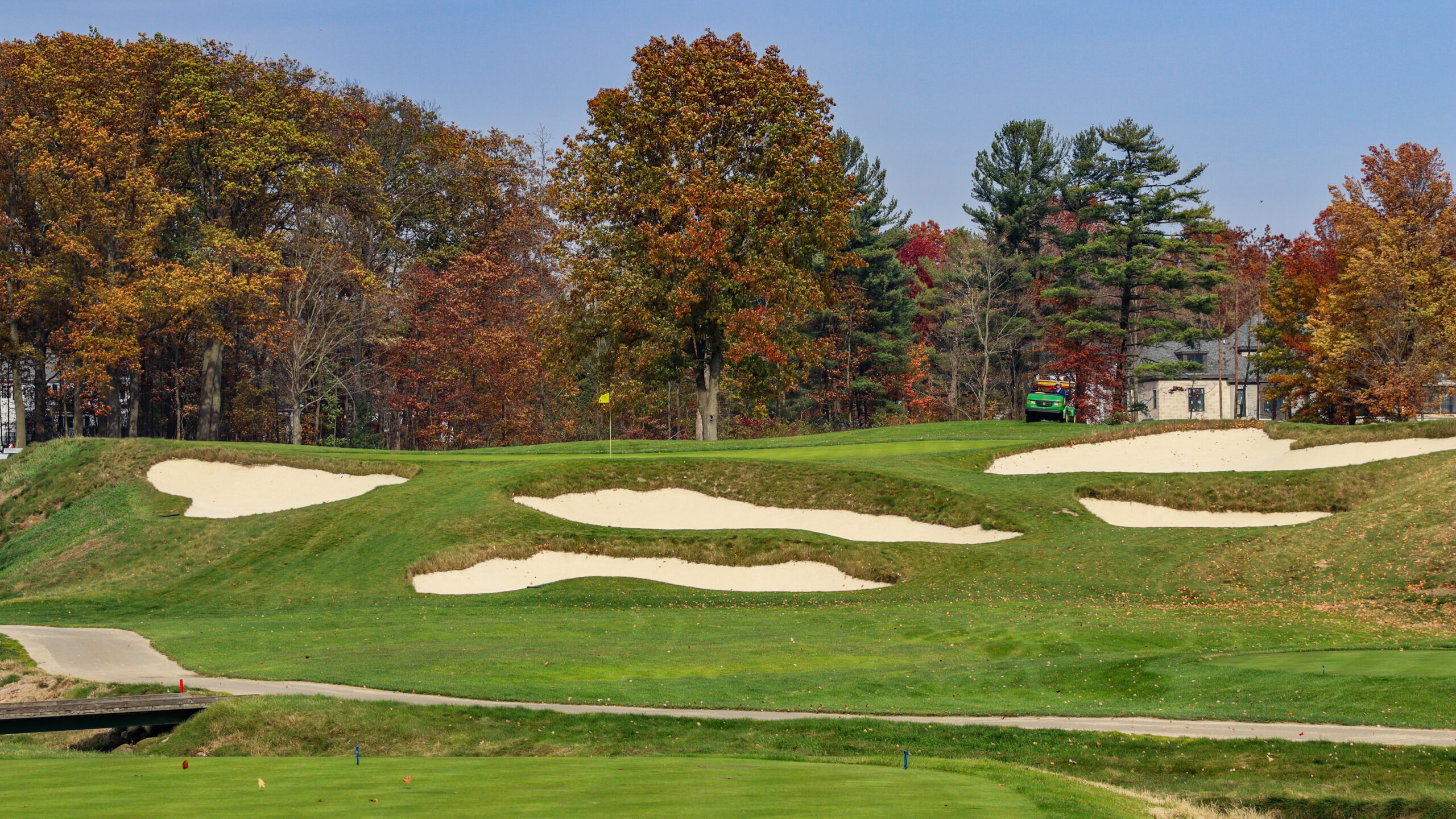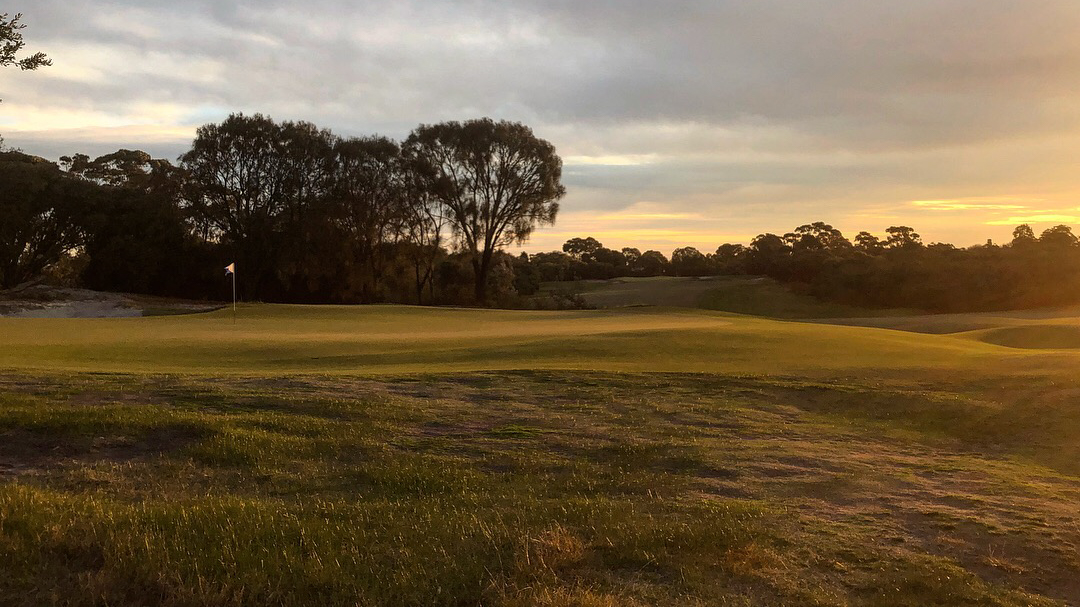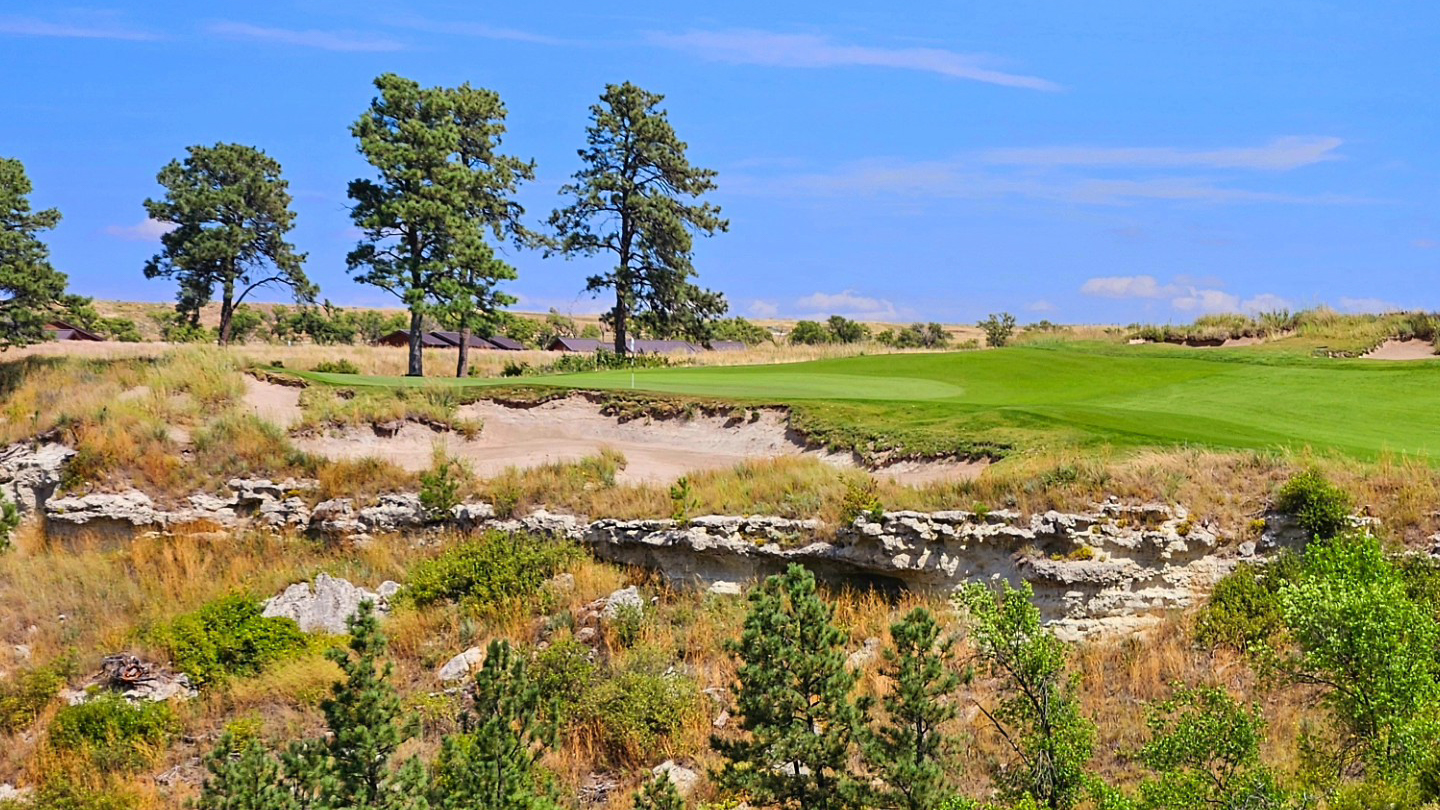Andrew Harvie (AH): As a current shaper for Gil Hanse & Jim Wagner, what have been some of the most interesting projects you’ve worked on?
Josh McFadden (JM): Restorations wise, something like Southern Hills, or The Country Club in Cleveland. Southern Hills was interesting because going into it I had only seen the golf course from watching the US Open and PGA Championship. I really didn’t know what to expect as those events were years before I ever stepped foot on property. That was my first opportunity to really put stuff back to how old photos and aerials were. Watching it come down to the wire [in the 2021 PGA Championship] with Mito Pereira knocking it in the creek on 18 was great, it was nice to see some of what I touched influence the outcome.
At The Country Club, having the trust of Gil Hanse and Jim Wagner was awesome. There were moments where you sort of question some of what Flynn did, ie. The grass faced bunkers on number 15, or just how different 17 came out compared to 11. The bunker style slightly changed all through the property. It would have been fascinating to ask him at the time why he did what he did. At the end of the day, that’s what was there, and you just put it back. The end result came out amazing.
For new builds, what we did at La Costa last year was really fun. It wasn’t the best golf course to start with, but to have the creative freedom to do what we wanted was refreshing. We tried to build something the NCAA would appreciate while still challenging the resort golfers.

The 11th at The Country Club, Ohio post-restoration
AH: For those who don’t know, you’re a Canadian—born in Manitoba. So how, if at all, did that affect your outlook on golf course architecture?
JM: Growing up in rural Manitoba you didn’t really have much to draw inspiration from. Most of what you were exposed to was pretty lousy. Conditions were fine for the short season we had, the pressure put on the turf from heavy cart traffic, and the type of turf we could grow. I was lucky I grew up near a course that was maintained well and was fun to play. The course was shorter, but it had an interesting routing sequence, and a great little finish with a 280 yard par 4 over water. A lot of matches came down to the 18th where you’d make eagle or birdie to win, or rinse it and make a complete mess of it. With a small green and lots of hazards around the green, anything was possible. Many of those fun moments will end up affecting my design philosophy down the road.
When I finished high school, I moved into the city. My parents had a house that backed onto the 1st hole of the Mackenzie nine at St. Charles in Winnipeg. I would sneak onto the golf course late at night to play a few holes. It was designed to a much higher standard than I grew up with, so I was beginning to see there was more to golf. I had no idea who Mackenzie was, but after playing on those green complexes I knew there was some serious thought put into it.
AH: In fifty years time when you look back at your career, is restoring or fixing some of the Stanley Thompson or Donald Ross designs in Winnipeg that haven’t been cared for as much as some of the others in their catalogue on your bucket list?
I used to have dreams of being able to get into a place like Pine Ridge. The bones are great, and it’s a fantastic little property. Elmhurst next door has had some work done, but they haven’t really completed a master plan as far as I know. Clubs in Winnipeg would rather use the golf season to make money, so understandably the appetite is truly never there for a full season renovation. It would certainly be fun to do if given the opportunity!
JM: What was the moment that made you want to get into golf architecture as a career?
Being in St Andrews working on the turf side of things allowed me to see and play everything in Scotland I wanted to. It ended up taking me over to Northern Ireland as well. That was the start of getting to see good golf courses, and also gave me exposure to great golf architects. You would play a golf course like Portrush and ask “who is Harry Colt?” That would give you something to research, and from there it just spirals.
After that, I went to the Los Angeles Country Club. It had just been touched up, and I got to see something very fresh—and very good. I liked what I was doing there—whether it was touching up the barrancas, maintaining bunkers, or just adding texture to the layout—I found it very fulfilling because you could see a tangible difference.
Ben Hillard, one of my good friends who also works for Gil Hanse, was on the Olympic project in Rio. The guys needed help down there, and an opportunity was presented. Unfortunately, I wasn’t able to make that my first job with Gil and Jim, but a year or so later I got another call. The rest is history.

AH: Outside of golf, what hobbies or interests do you have?
JM: I try to ski! I wouldn’t say I’m a skier, but I’m pretty decent. As you get a bit older, you lose the no-fear attitude you had as a kid that is required to be a great downhill skier. You start to second guess “if I mangle my right leg, is this going to affect my dozer operating abilities?”
I live in Alberta now, so anytime I get the chance to hike or ski, I take it. If I’m outside, that’s my happy place. No mountain biking yet. I have a friend who has tried to get me into it, but life gets in the way.
AH: Let’s dream a little bit: a client comes to you with a new build opportunity… how much of your own personal flavour would influence the design, and how much would Gil & Jim’s style play into your outlook?
JM: I think this depends on the client and how they’re coming to me. If they’ve seen work Gil & Jim have done, and understand I played a role in that work, then they may want something similar. If they’re looking for something a little different then I’m sure we can find a starting point. The great thing about working for the guys is that we’ve done so many different styles of projects, different budgets with all different types of land. I’ve been lucky enough to work on projects with big name architects too, that’s helped so much. I’m pulling from names like Perry Maxwell, William Flynn or Donald Ross.
When you start in the business, you have all these ideas in your head you’re trying to get out. Maturing a little allows you to show a little restraint. And over time, that slowly has matured into a nice balance. I guess you could say that comes from Gil & Jim. Just the maturity I’ve gathered over the years comes from their editing, but at the same time, it’s my own style now.
In Manitoba for example, if I were building a golf course I wouldn’t necessarily need or want a lot of sand. Sand is hard to get and it’s expensive. People don’t have the money to rake it, so why bother? Build some gnarly cool ground contour with some really great horizon lines, and you’re set. One place I always keep going back to is Winter Park, where Keith Rhebb and Riley Johns built a really good set of greens on some not-so-great land, minimal bunkers, and great horizon lines. When you do that, it becomes interesting. In my mind, if you can move water and build a great green with a good horizon line, you’re going to build something people will enjoy.
AH: Something Tom Doak has written a lot about on the Golf Club Atlas forum and beyond is how projects change depending on who is working on his crew. Gil isn’t as public about his projects as Tom is, but do you guys have creative freedom on-site, or is it pretty solidified in the planning stages?
JM: We have a ton of creative freedom and have fun with it! Using La Costa as an example, we had a great team of Neil Cameron, Brent Vest, and myself. We’re always communicating and sometimes it works, sometimes it doesn’t. At the end of the day it’s Gil’s call, but he’s fully supportive and wants to trust the guys he’s hired to make the right call. Not only that, but nurturing those concepts or ideas everyone has gets the most out of everyone.
AH: What’s your personal favourite golf course, and why?
JM: Too many good ones to pick from! If I had to play something every day, it would be the New at St Andrews. It’s such a good little golf course, and one that—like Pinehurst No. 2—I could see myself enjoying every day. I love going back to Royal Melbourne as well. I guess I didn’t get around to answering the question, but really anything that’s an easy walk.

Royal Melbourne
AH: Other than Gil Hanse, who else have you worked for?
JM: No architects. I started under Goodwin Golf in Alberta. Charlie Goodwin runs a great company and on top of that, he’s a dynamite human being. I also worked for KCM golf for a season at Crowsnest Pass in Alberta. Dave and Bryan kept me busy from May until the end of October, at which point I left to do work for Gil in Japan. I’ve been pretty fortunate to be with Gil and Jim since 2015.
AH: Do you have three songs you’re listening to that you like right now?
JM: No songs, but lets go with three podcasts I enjoy while being in the machine. The Rest Is History, 32 Thoughts, and The Shotgun Start. With TRIH, you can get into a seven or eight part series on the American West or the French Revolution—stuff like that. I find music is more of a car thing and these days, my commute is very short. I use 32 Thoughts to keep up with hockey, and I listen to The Shotgun Start because it’s just ridiculous. Those guys are mad! I like a little bit of golf, but I don’t want too much. Those guys are just busting balls—guy stuff, which makes it fun.
AH: Do you have a couple favourite projects you’ve ever worked on?
JM: CapRock Ranch for sure. Good piece of land, good people, and a lot of time with just Gil and I. We spent a lot of time going around the greens and really assessing what the land had given us, what we liked about the first 11 holes the guys had built, and how that would affect the last 7. It was really enjoyable getting to spend that much time with him on such a cool project.
AH: Out of all the projects you’ve been on, which one have you had the most impact on?
JM: Royal Sydney, where I’m at right now. There’s this next step with being over in Australia where you’re not just the point man on the job, you’re the guys eyes and ears on all things job related. The schedule doesn’t allow them to come in and out as they would in America, so it can make things challenging. There’s so much more trust in decision making that’s really allowing me to grow as a professional.
AH: We’ve seen this evolution in the past few decades of golf design, beginning with Sand Hills which ushered in this modern minimalist flavour. Conceptually, where does golf architecture go from here in your mind?
JM: If I’m being honest, I don’t have a clue. I think there is so much good stuff out there right now. In my opinion, everything has been done, we just haven’t discovered it all yet. If we’re going to spin off on some of these amazing ideas, and really incorporate it into a larger build as a whole, I think that could spur a new type of design.
There’s also going to be such a huge emphasis on minimizing material supply in the next 10-20 years. Products are going up in price and clients are going to be trying to stretch their money as far as they can in order to stay competitive. That’s one of the skills I think I really bring to the table for future work that I’ve learned form Gil & Jim. We’re extremely accurate with our quantities, and pride ourselves on sticking to a budget and programme.
AH: Dream projects: both restoration and a new build where money is no object, the client is good, and everything’s all good. Where would you build?
JM: Deep down, I’m a Midwest guy. We’ve got some pretty special bits of land, with a lousy short window of a golf season. Anything in and around Minnesota or Northern Michigan excites me. There’s great variety in land, wonderful vegetation and a great opportunity to build more desirable golf.
For a restoration, I don’t want to be romantic and say “Cape Breton Highlands Links,” but I would love to pick something in Canada. Let’s be a dreamer and say there’s a Donald Ross course in Manitoba mentioned earlier, a Willie Park in Ottawa, and a Dick Wilson in Montreal just to name a couple.
AH: In the hypothetical scenario that new build goes through, who are the three shapers you would hire to work with you on that?
JM: I’m going Kyle Goalby and Matt Smallwood, the packaged deal. They both did great work at Country during and after my time there. Secondly, Neil Cameron who I’ve worked with for years. And finally, Ryan Farrow. I would feel comfortable leaving the site as the architect with that crew. They’re going to build good, solid golf, and I’d really enjoy working with all of them.
AH: Who is your hockey team?
JM: Don’t kill me, Canada, but the Detroit Red Wings. I grew up in a Red Wings household because my grandfather played for the Wings in the 40s and 50s. They had great teams while I was growing up, and who can forget the rivalry they had with the Colorado Avalanche in the 90’s and 2000’s.

James McFadden
AH: What are the five golf courses you want to see next that you haven’t yet?
JM: I’ll put the entire Sand Valley resort as one. I’ll go back to Oakland Hills and see the North—I’ve spent a bunch of time on the South, but haven’t crossed the road yet. The North at Oakland Hills is a project I’d love to do under Gil with my Michigan ties. Add in the The Loop, Crystal Downs and finally, Cherry Hills in Denver. I think I should be able to see those five next year, so it’s a realistic list!
AH: There’s so many shapers and practicing architects these days, so what is it about you that makes you stand out from the crowd?
JM: There’s a lot of consistency and predictability in the quality of work that the best put out, and I like to think I’m in that group. It’s also being responsible with the client’s time and money, which is so important to me. I value my own time and respect theirs is worth just as much. At the end of the day, I don’t want to build just another average golf experience. If I’m putting a piece of myself into a project, the end result needs to represent how important that moment in life was to me.
Through Gil & Jim I’ve developed relationships with some very unique individuals. One of the many things I’ve taken away is that clients deep down have curiosity about the project, but aren’t sure which direction to take. Being able to communicate effectively and confidently really goes a long way. You’re talking to these people as though they’re people, not dollar signs. They’re humans with families, friends and passion for the same thing you’re passionate about. They respect the honesty in a respectful manner, and value that you want to see the best result possible, which is ultimately their vision as well. Being confident and honest goes a long way in both business and friendship.

CapRock Ranch






